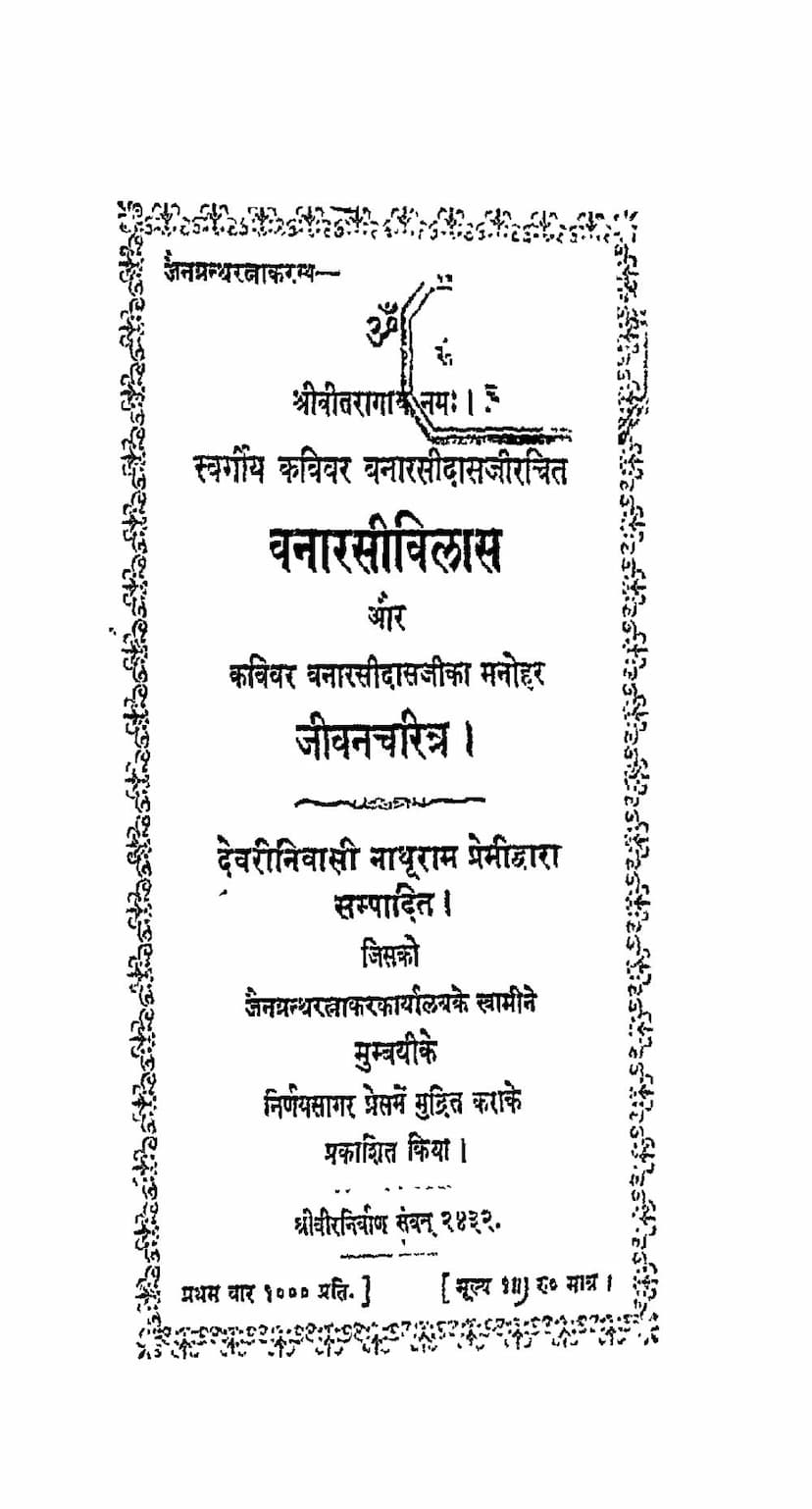Banarasivilas Aur Kavi Banarsi Ka Jivan Charitra
Added to library: September 1, 2025

Summary
This is a comprehensive summary of the Jain text "Banarasivilas aur Kavi Banarsi ka Jivan Charitra" by Nathuram Premi, based on the provided PDF pages:
Book Title: Banarasivilas aur Kavi Banarsi ka Jivan Charitra (Banarasivilas and the Life Story of Poet Banarasi) Author: Nathuram Premi Publisher: Jain Granth Ratnakar Karyalay
Overview:
The book is a compilation and biographical account focused on the life and works of the renowned Jain poet Banarasidasji. It was compiled and edited by Nathuram Premi and published by Jain Granth Ratnakar Karyalay in Mumbai. The publication date is given as "Shri Veer Nirvana Samvat 2432," corresponding to the Gregorian calendar year 1906.
Key Themes and Content:
The introductory sections (Uttanika) and the subsequent chapters, particularly the biographical account of Banarasidasji, highlight several important themes and aspects:
-
Critique of Contemporary Literature: The author, Nathuram Premi, begins with a critique of the prevailing literary trends of his time. He laments that much of the literature was heavily focused on shringar rasa (the erotic sentiment) and lacked depth or focus on spiritual and philosophical themes. He argues that while shringar rasa is a necessary component of literature, its excessive use can be detrimental. He calls for poets to explore other sentiments, especially shanta (peace) and karuna (compassion), which he considers paramount from a spiritual perspective.
-
The Importance of Jain Literature and its Historical Context: The text emphasizes the rich history and significant contributions of Jain authors to Indian literature. Premi points out that ancient scholars, despite their religious differences, engaged in respectful study and appreciation of each other's works. He cites examples of great poets like Banabhatta and Vagbhata, who were Jains and praised contemporary poets from other traditions (like Harishchandra and Kalidasa, respectively). This historical perspective is used to advocate for a more inclusive and less sectarian approach to literary criticism and preservation.
-
Challenges Faced by Jain Literature: Premi discusses the difficulties faced by Jain literature in gaining recognition and dissemination. He notes that some Jain communities were resistant to printing their scriptures, leading to their scarcity. Furthermore, he observes that existing Jain publications and literary journals were often biased towards Jain literature, neglecting or criticizing other traditions, and vice versa. He highlights that general Hindi publications often either ignored Jain texts or provided superficial and critical reviews.
-
The Life and Works of Banarasidasji: The core of the book is dedicated to Banarasidasji.
- "Ardha-Kathanak" (Half-Life Story): The author was fortunate to obtain a handwritten autobiographical account by Banarasidasji himself, titled "Ardha-Kathanak," covering his life up to 55 years. This is presented as a remarkable historical document, challenging the notion that Indian scholars did not write biographies. Banarasidasji's autobiography is praised for its candidness in discussing both his virtues and flaws.
- Genealogy and Early Life: The text traces Banarasidasji's lineage, starting from the Rajput community of Behroli village, who converted to Jainism. It details his father Kharagsen, his grandfather Mooldas (a learned accountant in the Mughal court), and his great-grandfather Jindas. It mentions his birth name Vikramjit, which was changed to Banarasidas by his father during a pilgrimage to Banaras, a city significant for its association with the Jinas Parshvanath and Suparshvanath.
- Personal Struggles and Conversions: Banarasidasji's life was marked by considerable hardship, including financial difficulties, loss of family members, and personal moral struggles. He experienced periods of indulgence in worldly pleasures, followed by profound spiritual awakenings and periods of deep devotion. His life journey involved engaging in trade, facing persecution, and seeking spiritual guidance.
- Spiritual Journey and Influences: The text highlights Banarasidasji's deep devotion to Lord Parshvanath and Suparshvanath. It also mentions his interaction with the Jain monk Yati Bhanuchandra, from whom he learned various subjects, including grammar, philosophy, and Jain practices. Despite his spiritual leanings, he continued to grapple with worldly desires, as evidenced by his internal struggles and eventual renunciation of certain worldly activities.
- Literary Contributions: The book identifies several of Banarasidasji's key works, including:
- Banarasivilas: A collection of his poems, compiled by Pandit Jagjivanji.
- Natak Samayasar: A highly acclaimed commentary in verse on the "Samayasar" text, considered a masterpiece of Jain literature in Hindi.
- Namnala: A glossary of words.
- Ardha-Kathanak: His autobiography.
- Other works like Gyanpachchisi, Dhyanvattisi, Adhyatmvattisi, Shivmandir, and various devotional poems are also mentioned.
- Banarasidasji's Philosophy: The author emphasizes that Banarasidasji's poetry, while sometimes touching upon worldly themes, was ultimately rooted in spiritual inquiry and detachment. None of his significant works were focused on shringar rasa (erotic sentiment), but rather on spiritual teachings and self-reflection. The text notes his unique approach to incorporating the Navarasas (nine sentiments) within a spiritual framework in his works.
-
Preservation and Promotion of Hindi Literature: Nathuram Premi expresses a strong desire to promote Hindi literature, particularly Jain literature, which he believes has been overlooked. He calls upon literary societies and patrons to support the publication and study of these valuable texts. He highlights how Jain literature, especially through its Hindi translations and commentaries, has contributed significantly to the development of the Hindi language itself.
-
Literary Criticism and Analysis: The book includes detailed analysis of Banarasidasji's poetry, discussing its style, sentiment, and spiritual significance. The author draws parallels between Banarasidasji's introspective and spiritually inclined poetry and the broader landscape of Hindi literature.
Conclusion:
"Banarasivilas aur Kavi Banarsi ka Jivan Charitra" serves as a significant work for understanding the life and literary contributions of Banarasidasji, a pivotal figure in Jain literature. It also functions as a platform for Nathuram Premi's broader advocacy for the recognition, preservation, and promotion of Jain literary heritage within the larger context of Hindi literature, emphasizing the importance of spiritual depth and ethical values in creative expression. The detailed biographical account, drawing from Banarasidasji's own writings, provides invaluable insights into the poet's multifaceted life and spiritual evolution.